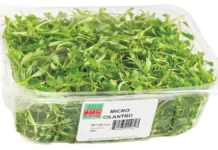The New York Department of Health is reportedly pondering new standards that would require all fish for sushi and ceviche to be frozen, and some restaurateurs are not happy about it.
The new rule would state that all fish meant to be served raw – as sushi or ceviche or seafood tartare, for example would have to be kept frozen until it was served. Wild tuna and farm-raised fish would be exempt. The goal of the new regulation would be to prevent parasites, which can’t survive the freezing process.
The New York State Restaurant Association says that requiring sushi fish to be kept frozen until serving would reportedly mean that a lot of smaller restaurants would have to buy expensive new freezers. Because freezing could change the texture of certain fish, the new regulation would also reportedly affect service at high-end restaurants. This affects the high-end restaurants like Marea and Le Bernardin that specialize in seafood, and the sushi restaurants like Nobu,” said Chris Hickey, NYC regional director of the New York State Restaurant Association.
To many food lovers, sushi has become a near religion, and a cornerstone of the faith is that the fish is extraordinarily fresh. Its priests are chefs with seemingly mystical abilities to summon fresh fish from all corners of the globe.
But because of health concerns and growing demand, 50 to 60 percent of sushi in the United States is frozen at some point in its journey from the ocean, according to wholesalers. And rare is the sushi restaurant that tells customers upfront that they may be eating fish that has been in deep freeze for up to two years.
Most would be even more surprised to learn that if the sushi has not been frozen, it is illegal to serve it in the United States.
Food and Drug Administration regulations stipulate that fish to be eaten raw – whether as sushi, sashimi, seviche, or tartare must be frozen first, to kill parasites. ''I would desperately hope that all the sushi we eat is frozen,'' said George Hoskin, a director of the agency's Office of Seafood. Tuna, a deep-sea fish with exceptionally clean flesh, is the only exception to the rule.
But tuna is often frozen, too, not necessarily to make it safe, but because global consumption of sushi continues to rise. Frozen fish usually costs about half as much wholesale as fresh. And some cuts, like the prized fatty toro, are not always available fresh.
Naomichi Yasuda, the owner of Sushi Yasuda, the acclaimed sushi restaurant in New York City, said he imported fresh tuna but froze it himself, selling it for $10 a piece.
''American customers don't want to hear that something is out of season,'' he said. ''People want toro every day.''
At the Elizabeth, N.J., warehouse of True World Foods, a manager, Ken Kawauchi, recently readied a room-size freezer to receive eight more tons of premium tuna frozen with sophisticated technology that chefs say preserves the texture and flavor of the fish.
''This product is better than fresh,'' he said. ''We start freezing it almost before it's dead.'' At 76 degrees below zero, you can feel your hair follicles freeze. A 20-pound chunk of premium bluefin tuna is rock hard and cold enough to burn a blister on your finger.
But all it takes is a band saw, 10 minutes and a bowl of warm water to produce deep red, dewy slices of the finest sushi money can buy, the same toro served at Manhattan sushi shrines.
Sabine Marangosian, who works in Midtown Manhattan, said she ate sushi ''at least once a week.'' ''I guess I would understand that some sushi is frozen,'' she said. ''But I would hope that's not the case at Nobu.''
But Shin Tsujimura, the sushi chef at Nobu, closer to Wall Street, said he froze his own tuna. ''Even I cannot tell the difference between fresh and frozen in a blind test,'' he said.
Even Masa Takayama, whose sushi temple Masa, in the Time Warner Center, charges a minimum of $300 to worship, said he used frozen tuna when fresh is unavailable.
Many sushi bars, in Japan and elsewhere, routinely use frozen fish when fresh is unavailable or more expensive than the market will bear.
''In Japan,'' Mr. Kawauchi said, ''50 percent of the sushi and sashimi is frozen. Only my American customers are so concerned with fresh fish.''
Americans have clearly overcome the initial resistance that greeted sushi when it was widely introduced nationally in the 1980's.
The number of Japanese restaurants across the country has steadily increased in the past five years, according to the National Restaurant Association. And that number does not include the supermarkets, delis, cafeterias, and Costco stores where sushi can now be purchased.
A.F.C. Sushi, a Los Angeles-based sushi franchiser, has more than 1,800 outlets nationwide. It already supplies the Staples Center, in Los Angeles; Florida State University, in Tallahassee, Fla.; and the United States military, which buys sushi for its commissaries. Although the company's Web site refers to ''fresh sushi,'' A.F.C. uses only frozen fish in its products.
Tuna, one of the most expensive sushi fish in the world, has been the test market for superfreezing.























